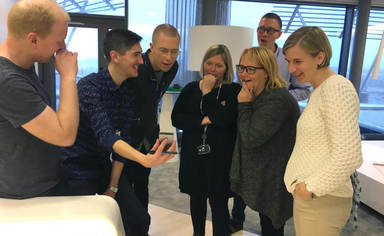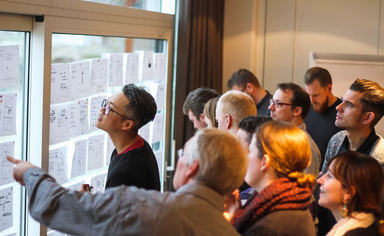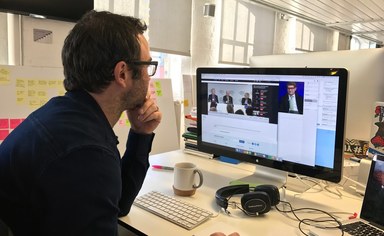At Made by Many we place a huge value on face-to-face contact with our clients. It improves productivity and helps build strong relationships – if it’s done right.
If it’s done wrong, it leads to low energy levels, impairs productivity, and reduces the likelihood that a project will deliver against its objectives.
So how do we make sure that we have the right co-location approach for a project?
I. Consider the cadence of the project
II. Assess the co-location options
III. Set up the plan and workspace
I. Consider the cadence of the project
Different styles of product project demand different workflows and rhythms:
- When team members don’t know each other well, face-to-face contact is more important then when they’ve worked together for a while. In a client-service company like ours, building strong working relationships with both individual clients and teams is key to our success, and this is easier done in person than on the other side of the world.
- When you think you’re going to need to adjust the plan a lot, face-to-face contact is more important than when planning cycles are predictable (for example, when you’re working in Scrum-style sprints). It’s easier to negotiate, agree and communicate changes to a plan when you’re all in the same place.
- In general, when levels of ambiguity are high, face-to-face contact is more important than when uncertainties are largely resolved. Face-to-face conversation allows you to iterate through problem-opportunity-solution loops much more quickly than trying to do this over email (or phone or video calls). You’ll make more progress more quickly, and feel better about the outcomes.
How does this map to the sort of work we do at Made by Many?
- Vision and discovery projects: high intensity and high levels of ambiguity; fluid project planning and re-planning as opportunities emerge
- Proof of concept projects: moderate levels of ambiguity; level of intensity dependent on agreed scope with the client; more predictable planning cycle (we’re almost always in two-week sprints at this stage)
- Go to market projects: lower levels of ambiguity; reasonably predictable planning cycle
- Transform and grow projects: as a layer that sits above and around our other services, these are by definition deeply collaborative exercises; the most difficult to predict, and that need further discovery work before we can establish the best co-location approach
II. Assess the co-location options
We typically evaluate four options:
1. Made by Many team on client site for 50%+ of project time
This works well for early stage concept development projects where the teams are still getting to know each other and ambiguity levels around the product are high. It’s particularly effective when:
- the client side of the team is larger than the Made by Many side – this reduces cost
- the client is outside London – meaning that Made by Many bears the brunt of travel (we’re fine with that!)
2. Client team at Made by Many for 50%+ of project time
Very similar to the first option, but this is most effective when:
- the client wants to free themselves of the distractions of their own site to focus on the project at hand
- the client doesn’t have a suitable workspace for the project on their own site; this might be because of a lack of available space to host us, or because the space isn’t configured well
Why do we prefer the first option? It makes it easier for us to immerse ourselves in our clients’ worlds.
3. Regular onsite day(s) each sprint, either at client site or at Made by Many
This works well once the project has settled into a predictable rhythm.
For example, where we’re working in sprints, bringing the client to Made by Many for a day each sprint to hold a retrospective, estimate, prioritise and plan can be a very cost-effective way of achieving the right degree of face-to-face contact without a full-blown co-location.
This is particularly effective when:
- the client is outside London
- the client has a clearly assigned and empowered Product Owner who can participate in the regular onsite day
This is often a good solution for a short, intensive phase of a project – for example, if we have to compress a Vision and Discovery project into just two weeks, or run large scale workshops with a wide range of stakeholders.
It’s particularly effective when:
- the client is outside London
- the client wants to free themselves of the distractions of their own site to focus on the project at hand
- the number of people that need to be accommodated exceeds available space on either the client site or at Made by Many (particularly important for last-minute high-priority workshops)
This approach obviously carries a much greater cost, but can be very effective when deployed appropriately. Made by Many has extensive experience planning, managing, booking and running offsite workshops like this and our dedicated support team help everything run smoothly.
A final note on co-location options…
You’ll notice that neither of the intensive options are at the ~80% that a typical consulting firm spends on the client site. Why?
- most importantly, we and our clients both need time to work at different levels of intensity and privately; this might be to set up for group exercises, prepare research or models, or just to reflect on what’s been done
- it puts unnecessary pressure on team members; in our experience, 2 or 3 days a week on the client site yields the optimal level of productivity and anything more than that starts to disrupt our employees’ personal and family lives and health
- it’s (more) expensive; any co-location approach is going to incur costs, but we haven’t seen any benefits from going beyond 3 days
III. Set up the plan and workspace
Having selected the best co-location option, and bearing in mind that this might change over the course of a long term client engagement, we go about setting up the plan and workspace.
What do we need to think about?
- Calendaring: we try to plan all of the keystone meetings for a project as far in advance as possible; these might include checkins with the CEO or another senior stakeholder, and anything that requires large numbers of stakeholders to be in the same place or the same time, as well as making sure we avoid local and national holidays. It’s easier to reschedule than to schedule.
- Travel: for cities less frequently-served from London, the details of travel time can make a huge difference to our clients’ and our sense of wellbeing. If we schedule our sprint retrospective to start an hour later, we don’t have to wake up at 04:30 to get the early flight. If we can finish by 16:00, we can be back home in London by 19:00 (by way of an entirely hypothetical example).
- Workspace: we try to anticipate the needs of the space (desks for solo work; project rooms where we can leave things on the walls) as well as equipment (pens; paper; whiteboards) and IT for longer engagements (printers; monitors; keyboards and mice).
And a final, final note: these are guides, rather than rules. Every Made by Many engagement is designed around the needs of our clients, and we can (and have) accommodated almost anything within reason. The value of face-to-face contact is simply too high to be subject to arbitrary compromise.






